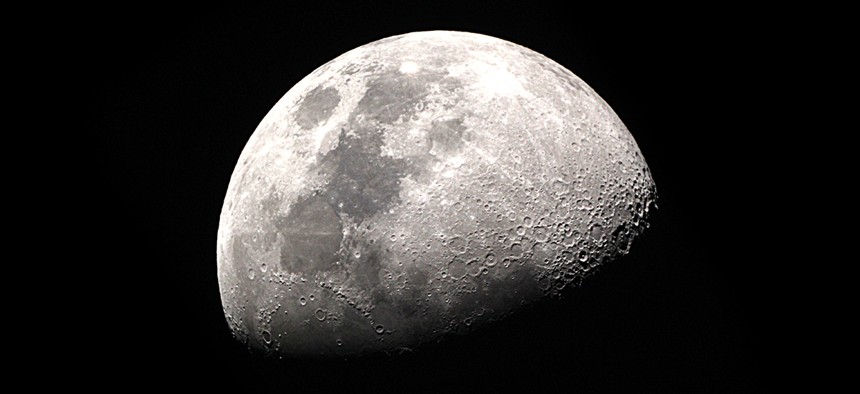No One Met the $20 Million Deadline for a Civilian Moon Mission

taffpixture/Shutterstock.com
The prize for a Google-sponsored competition to send spacecraft to the lunar surface will now go unclaimed.
A Google-sponsored competition to reach for the moon has fallen short.
More than 10 years after the XPRIZE Foundation announced a contest for proposals to send a robot to the moon, none of the participating teams will meet their deadline. The grand prize for the winner, $20 million provided by Google in a partnership with XPRIZE, will go unclaimed.
“After close consultation with our five finalist Google Lunar XPRIZE teams over the past several months, we have concluded that no team will make a launch attempt to reach the moon by the March 31, 2018, deadline,” wrote Peter Diamandis and Marcus Shingles, the heads of the XPRIZE Foundation that led the competition, in a post on Tuesday.
The competition called for privately funded teams to develop, launch, and land a spacecraft on the moon, drive it across the lunar surface for at least 1,640 feet (500 meters), and transmit high-resolution photos and video footage back to Earth. Google put up $30 million in prize money. The first team to complete the mission would receive $20 million and the second would get $5 million. The remaining $5 million was set aside for other accomplishments in the contest.
More than 30 teams entered the contest. The initial deadline was set as 2012.* In 2017, the foundation selected five finalists: Moon Express of the United States, SpaceIL of Israel, HAKUTO of Japan, TeamIndus of India, and Synergy Moon, an international team. By then, even though XPRIZE had pushed the deadline several times, the teams were still nowhere near ready to launch a spacecraft.
The contest doled out $6.25 million of the prize money to multiple participants between 2015 and 2017 for reaching various milestones in developing software and hardware for their missions. Google will now keep the rest of the money it contributed.
XPRIZE cited “fundraising, technical, and regulatory challenges” for participants. As for what’s next, XPRIZE said it could find another sponsor to contribute prize money or continue the competition without any cash prize.
The five finalists had made some significant progress. All had signed contracts with launch companies to send their spacecraft to the moon, including one with SpaceX, Elon Musk’s company. (Nature reported last week that TeamIndus may have lost its contract due to lack of funds.) Moon Express even received approval from the U.S. government to land on the lunar surface, a first for a private company. But it’s not clear how far the companies made it in the development of their hardware. “Our teams are in different stages of construction of their spacecraft,” an XPRIZE spokesperson said Tuesday.
The idea for the robotic moon mission arose from a meeting of big names in Los Angeles in 2007. Three years earlier, XPRIZE had wrapped up a competition that awarded $10 million to a team that designed and built a suborbital space plane called SpaceShipOne. The foundation was searching for a new target. Spencer Reiss reported on the meeting back then in Wired:
A morning brainstorm featuring Google’s Larry Page and Virgin’s Richard Branson had already turned up scores of possible new XPRIZE targets, from early cancer detection to ultracheap solar energy. During a break for lunch, Page dropped one more on the XPRIZE chief Peter Diamandis: He and the Google cofounder Sergey Brin had been “kicking around” the idea of sending low-cost robotic landers to the moon.
Diamandis, who has been launching extraterrestrial enterprises since he was an MIT undergrad in the 1980s, grabbed his laptop and disappeared, returning half an hour later with a freshly minted PowerPoint deck. Page looked it over, then said, “Talk to Sergey.” That evening, as the guests sipped cocktails in the shadow of the little white space plane, Diamandis cornered the Google technology chief and pitched. Brin loved it. “Some endeavors are too speculative, even for venture capital,” he says. “If they’re really worth doing, you try to find some other way.”
When the competition was announced, XPRIZE said it wanted to create a “global private race to the moon.”
“It has been many decades since we explored the moon from the lunar surface, and it could be another six to eight years before any government returns,” the foundation said. “Even then, it will be at a large expense, and probably with little public involvement.”
A decade later, the moon is having a moment. In late 2018, China hopes to launch the Chang’e 4—a combination of a lander and a rover—to touch down on the far side of the moon, a first for humankind. Elon Musk said last year that he wants to send two paying customers on a trip around the moon sometime in 2018 aboard SpaceX’s Crew Dragon spacecraft, which would be launched by the Falcon Heavy, a yet-to-be-tested rocket. The Trump administration has pushed the direction of U.S. space policy back to the moon as a destination, rather than a quick pit stop on humanity’s way to Mars. The next decade could very well see some human presence on the lunar surface again, whether there’s prize money in it or not.






